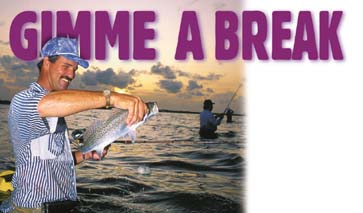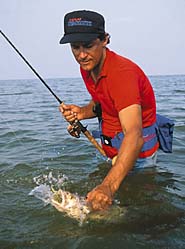|

By Buddy Gough
Target the underwater breaks
that mark key gamefishing action zones
Trout on the line proved what little difference a
year had made for wade angling excellence along the outside beaches
of Aransas Bay.
Rockport fishing guide Jay Watkins had his clients
Bryan Snowden, Bryan Jr. and Gordon Kidd wading abreast along
a shoreline of hard sand and scattered shell. Casting KelleyWiggler
shrimptails and Bass Assassin plastics, the four anglers were
regularly and happily hooking up with hungry specks like deja
vu.
The last time I had seen Snowden and his son was
364 days earlier at the end of a 100-fish day of wade fishing
action with Watkins. The memorable results called for a rematch,
and it didn't take any arm-twisting for me to join the game -
especially not when Watkins said he was on a sure-fire fishing
pattern in conditions of spring-like weather.
 The guide had been particular when he deployed his
offensive line for the first wade of the morning. He positioned
us about 20 yards apart in a line perpendicular to a shoreline
to cover water from knee-deep to chest-deep. He said the formation
would allow us to cover both sides of what he called the "break." The guide had been particular when he deployed his
offensive line for the first wade of the morning. He positioned
us about 20 yards apart in a line perpendicular to a shoreline
to cover water from knee-deep to chest-deep. He said the formation
would allow us to cover both sides of what he called the "break."
"The plan for this first drive is to move quickly
down the field and get some points on the board," Watkins
explained. "We are not looking to run some time off the clock."
We scored 17 on the first drive, including 16 stout
keeper specks and a good-sized flounder. The trout ranged from
16 to 21 inches, but they were so thick-bodied that the larger
ones pushed 3 to 3-1/2 pounds.
Watkins was just as careful with our deployment for
a second wading foray along a shoreline featuring a bottom of
mixed sand and grass. This time, however, we lined up from waist-deep
to chest-deep.
"We are going to line up to cover from the edge
of the `break' to as deep as we can wade," he said as we
prepared to leave the boat.
"Why is that?" he asked. "Think about
the line of water where we caught fish on our first wade. They
were a little deeper off the break. That's where we should find
most of them along the shorelines this morning."
It was lore related to the time-tested pattern of
fishing what the professional guides frequently refer to as "edges,"
"breaks" and "dropoffs." It sounds like Fishing
101, but it became a bit more than that when Watkins explained
and demonstrated the finer points of wading the breaks.
He scored a point on the second shoreline when he
caught a keeper trout on his first cast zinged offshore from the
deep end of our wading line.
"See?" he laughed, "I just proved
that there are 100 percent more fish in deep water on this shoreline
than there are in shallow water."
Over the next several hours of wading the breaks
along selected shorelines, Watkins continued to find keeper-sized
trout in varying numbers - a few on a poor stretch, 10 on a better
one and 26 on a hot stretch at high noon. More action followed
in the afternoon until the Snowdens could count a 100-fish day
to match the success of the previous year. The large majority
were caught on the deeper side of the break in water averaging
about 4 feet deep.
It was like the trout were concentrated in a river
meandering along the shores of San Jose Island. All the while,
Watkins expounded on how to stay in the scoring "zones"
for fishing action.
Essentially, there are three zones to target.
continued
page 1 / page 2
| 




